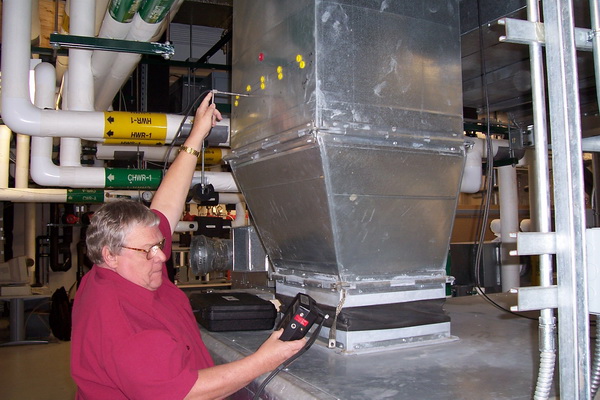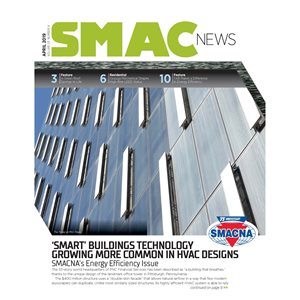Testing and Balancing: Making a Difference in Energy Efficiency
SMACNA’s testing, adjusting, and balancing contractors are expanding their businesses by focusing on building systems and helping building owners and operators utilize their HVAC systems more efficiently.

A technician performing a duct traverse test in supply ductwork.
SMACNA’s testing, adjusting, and balancing contractors are expanding their businesses by focusing on building systems and helping building owners and operators utilize their HVAC systems more efficiently.
Testing, adjusting and balancing (TAB) contractors provide professional, objective testing of a building’s heating, ventilation and air conditioning systems. The information shared with customers comes from a series of evaluations of a building’s HVAC system. In addition to evaluating operations, TAB contractors conduct duct leakage tests and perform systems commissioning.

A blower door measuring “room tightness.”
Energy Balance and Integration (EB&I) of Albuquerque, New Mexico, seized the opportunity to optimize energy efficiency for companies in several different ways — by partnering with engineers to test systems, by assessing systems while balancing a job, and by testing hospital and lab rooms for positive air pressure to keep room environments hygienic.
A building needs to be seen as a holistic system. “A lot of the time the customer looks at the building from the standpoint of just being an individual room, when there’s really a whole system working within a building,” said Anthony Kocurek, EB&I’s owner and SMACNA National vice president. “When you can make a whole system work more efficiently that’s where the real energy savings come in.”
EB&I will help engineers improve air efficiencies, thereby reducing the loads on fans and other motors. “We will test and balance for an engineer who wants to know how a building is working and he has been given the task of fixing it,” Kocurek said. “They will ask us to go in and do some auditing and figure out where things are at.”
“While we’re up there, we will take a look in the ceiling and look at how the ducts are run and how the connections are connected. If there is any known leakage, you will feel the air blowing around,” he explained.
“And as we start going through an analysis, we notice how the systems are working. If there is a VAV (variable air volume) box we will look at how the boxes are set up to see if the set up makes sense,” he said. “These are all things that can easily be corrected, and they make a big difference in the systems’ efficiency,” he said.
At that point, they give the engineer not only the results of the test, but also their recommendations for improving the building’s energy efficiency.
James Hall, P.E., president and owner of Systems Management and Balancing in Waukee, Iowa, said that in many cases they will also team up with the design professional. Hall also serves on SMACNA’s Board of Directors and Technical Resources Committee.
We’ll take a consulting role in a team approach,” Hall said. “Typically, the design professional will get us involved and say they would like to get some measurements and data here and there and learn our thoughts on how the system is operating to see if we can make some system modifications,” he added.
Systems Management also troubleshoots system problems. Most of the time it’s a comfort issue or a building operational issue — such as negative pressure or high humidity. “Buildings sometimes have pressure problems, which is interesting because it translates back to energy efficiency,” Hall said.
EB&I also tests hospitals and laboratories to ensure that rooms maintain positive air pressure. Isolation rooms, for example, require an environment where no contaminants can enter. “There are certain amounts of offset to supply air and exhaust return so you maintain room positive when the door is closed,” Kocurek noted.
To measure a room’s “tightness” or air pressure, they will install a blower door with fans in the door frame that pressurize the room. “It blows air into the room and we measure the amount of air being used to pressurize that room. Our goal is to create the least amount of air leakage as possible. It makes it very efficient. That has been an incredible savings for the engineers,” Kocurek said.
Hall’s company also performs testing, adjusting, balancing and commissioning as a third-party to verify that the building’s systems are operating efficiently. “We are the eyes and ears of the design professional to make sure it is doing what he or she wanted it to do,” Hall said.
“If something is not operating as designed, and not meeting design intent, we get into a semi-consultative role and work with the design professional and say, ‘here’s what we see and here’s what might help for next steps,’” he noted.
“Lots of times energy efficiency relates back to making sure the building is operating as intended,” Hall added.
“We have the good fortune to have the opportunity to help make the system work,” he reflected of his company’s role. “Every job we have is an opportunity to learn and we try to share that knowledge with our customer base. Every project we do is like a learning laboratory.”
“The future of energy efficiency goes back to helping educate the industry on what’s really happening with how a system operates,” he said.
Energy Balance and Integration »
Systems Management and Balancing »
Published: April 29, 2019
IN THIS ISSUE
‘Smart’ Buildings Technology Growing More Common in HVAC Designs
Energy efficiency is not just about the environment, its about smart business. This Energy Efficiency Issue covers a myriad of energy efficient projects including Pittsburgh’s groundbreaking PNC Tower – and SMACNA contractors were there to bring it
A Green Roof Springs to Life
On top of a pharmaceutical company’s parking garage in Wilmington, Delaware, there grows a thriving patch of countryside, courtesy of SMACNA member Ernest D. Menold Inc.
Canadian Firm Revamps Plant Exhaust System
Trade-Mark Industrial Inc. of Cambridge, Ontario is flourishing in Canada’s booming economy. Trade-Mark has approximately 1,200 men and women in the field in locations as far west as Manitoba and the United States.
Developing Leaders Through Feedback
Collectively, companies spend billions of dollars for leader development, utilizing everything from public seminars to executive MBA programs at prestigious universities. While all of these have value, people sometimes overlook one of the simplest
Geauga Mechanical Contributes to Luxury High-Rise’s LEED Status
Expertise in energy efficiency and early involvement in the planning process were the keys to a successful residential – and landmark – project for Geauga Mechanical of Chardon, Ohio, according to CEO Craig Berman, LEED AP, CEM.
President’s Column: Building on the Benefits of Energy Efficiency
Today’s emphasis on energy management provides contractors with several opportunities to expand their businesses and help buildings become more energy efficient.
San Diego Crime Lab Requires Complex Systems
Associate Mechanical Contractors' complex HVAC system for the San Diego county Crime Lab helped it achieve LEED-Gold status.
SMACNA Endorses Bipartisan Bill to Speed Hospitality Retrofits
SMACNA has enthusiastically expressed support for the bipartisan bill, Restoring Investments in Improvements Act of 2019 (S. 803), which would amend last year’s Tax Cuts and Jobs Act to boost renovations and retrofits for restaurants and retailers.
Solar Power Harnesses the Sunshine
Roofs can serve multiple purposes besides being the foundation for green roofs. Harnessing the power of the sun, for instance, as a solar energy source for buildings and homes. Some SMACNA contractors are venturing into the solar market, offering
Testing and Balancing: Making a Difference in Energy Efficiency
SMACNA’s testing, adjusting, and balancing contractors are expanding their businesses by focusing on building systems and helping building owners and operators utilize their HVAC systems more efficiently.
University Innovation Center Designed for Collaboration
The roof and façade design for a new academic building project created “the perfect blend of high-tech and natural esthetics” for the University of Maryland’s new Brendan Iribe Center for Computer Science and Engineering, according to Scott Callaway


